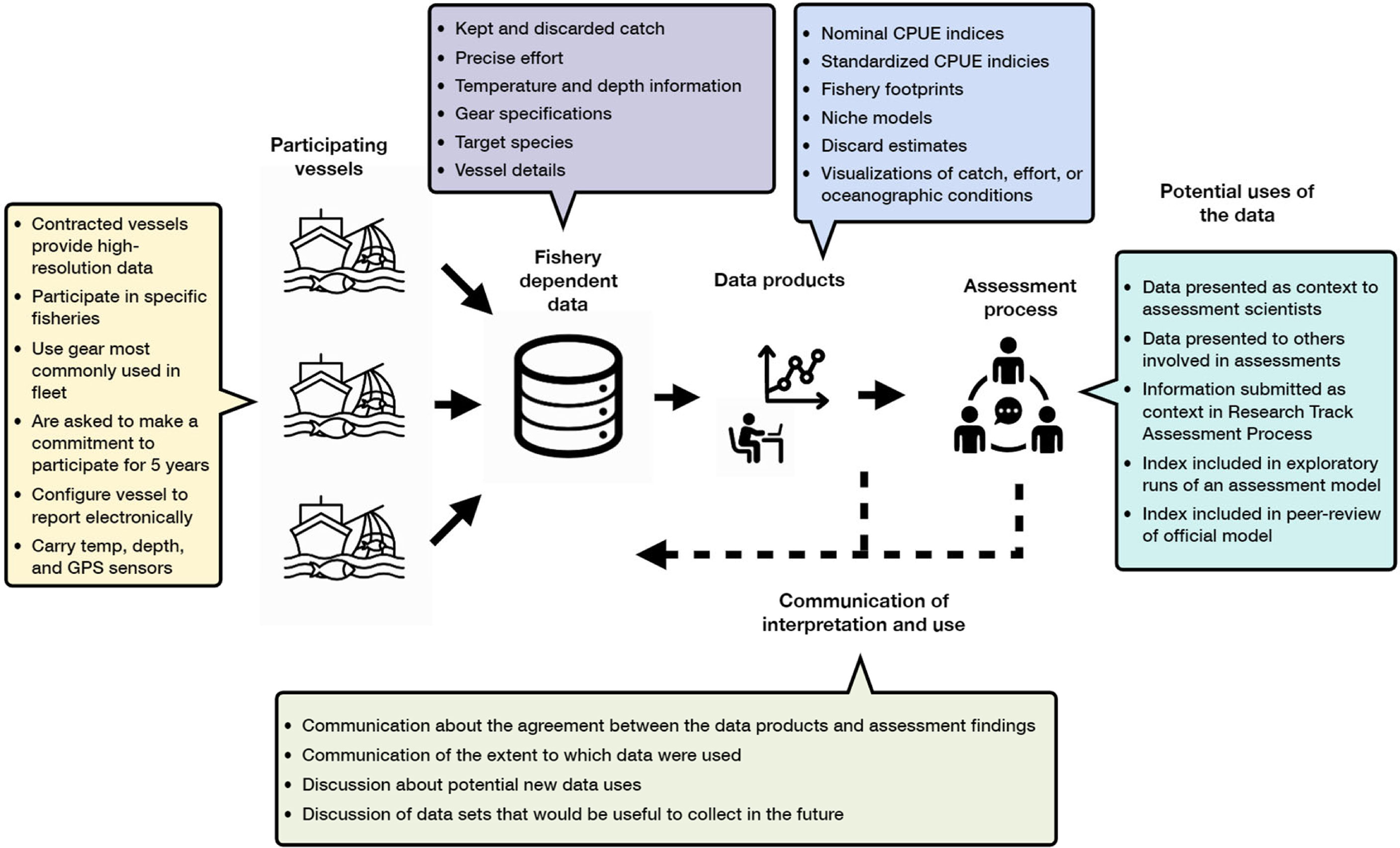class: right, middle, my-title, title-slide .title[ # EBFM “on-ramps” <br /> Using Ecosystem Information <br /> in the Stock Assessment and Advice Process ] .subtitle[ ## CMOD EBFM <br /> 15 November 2022 ] .author[ ### Sarah Gaichas<br /> Northeast Fisheries Science Center <br /> <br /> With thanks to Kimberly Gordon and Katie Latanich ] --- class: top, left <style> p.caption { font-size: 0.6em; } </style> <style> .reduced_opacity { opacity: 0.5; } </style> # US Policy defines EBFM as: ## A systematic approach to fisheries management in a geographically specified area that contributes to the resilience and sustainability of the ecosystem; recognizes the physical, biological, economic, and social interactions among the affected fishery-related components of the ecosystem, including humans; and seeks to optimize benefits among a diverse set of societal goals. .center[  ] .footnote[ https://www.fisheries.noaa.gov/resource/document/ecosystem-based-fisheries-management-policy ] --- .center[  ] .footnote[ https://www.st.nmfs.noaa.gov/Assets/ecosystems/ebfm/EBFM%20Myths%20v7.pdf ] --- ## EBFM Guiding Principles .center[  ] --- ## What is ecosystem information? An *indicator* tells us something about where we are relative to our goals or to limits, or about the context we are working within that may affect achieving our goals. <img src="https://github.com/NOAA-EDAB/presentations/raw/master/docs/EDAB_images/indicators.png" alt="bank account balance, speedometer, weather warning" style="display: block; margin: auto;" /> ??? as a big umbrella that can include many types of information A quick definition of ecosystem indicators, why they’re useful, and broad categories (e.g. climate, oceanographic, habitat, primary productivity, ecosystem services, human dimensions, etc.) --- ## What is ecosystem information? Performance relative to objectives An *indicator* tells us something about where we are relative to our goals or to limits, or about the context we are working within that may affect achieving our goals. .pull-left[ Stock status <img src="20221115_CMOD_onramps_Gaichas_files/figure-html/unnamed-chunk-6-1.png" width="504" style="display: block; margin: auto;" /> ] .pull-right[ Commercial Revenue and Recreational Effort <img src="20221115_CMOD_onramps_Gaichas_files/figure-html/unnamed-chunk-7-1.png" width="504" style="display: block; margin: auto;" /> .contrib[ Black = Revenue of all species combined; <span style="color:#FF6A6A;">Red = Revenue of MAFMC managed species</span> ] <img src="20221115_CMOD_onramps_Gaichas_files/figure-html/unnamed-chunk-8-1.png" width="504" style="display: block; margin: auto;" /> ``` ## Error in loadNamespace(x) : there is no package called 'arfit' ``` ] --- ## What is ecosystem information? Context, risks to meeting objectives An *indicator* tells us something about where we are relative to our goals or to limits, or about the context we are working within that may affect achieving our goals.  --- ## Documenting and sharing ecosystem information .pull-left[ ecosystem, stock assessment, and economic reports .center[  ] ] .pull-right[ fishery performance reports, cooperative research, working groups <!---->  .contrib[ [Jones et al. 2022, Learning from the Study Fleet: Maintenance of a Large-Scale Reference Fleet for Northeast U.S. Fisheries. https://doi.org/10.3389/fmars.2022.869560](https://www.frontiersin.org/articles/10.3389/fmars.2022.869560/full) ] ] ??? Pathways for documenting and sharing ecosystem information ESRs and what they can do (e.g. synthesize, provide context, help formulate hypotheses and questions, support communication, potentially inform specific decisions) Other vehicles (e.g., some regions that don’t yet have regular ESRs have mentioned SAFE reports, fishery performance reports, and others). *Don’t worry about being comprehensive here – in the discussion that follows this talk we’ll be asking people how they receive ecosystem information. --- ## On ramps: getting where we want to go .pull-left[ *Management decisions* 1. Where do we want to go? Key question. Start here 1. Current decisions + Stock assessments + SSC advice--ABC decisions + Harvest control rules 1. New (current) decisions + Habitat change or restoration + Changing species distribution and interactions + Tradeoffs between fisheries + Tradeoffs between ocean use sectors ] .pull-right[ *Methods and tools* 1. Stakeholder engagement, surveys, strategic planning 1. Add information to current process + Ecosystem ToRs, ESPs + Risk or uncertainty assessments + Management strategy evaluation 1. Integrate across current processes + Risk assessment + Conceptual models + Scenario planning + Management strategy evaluation ] ??? A basic orientation to ecosystem on-ramps – (however you would organize this) – e.g. assessments inputs, context for decision-making, risk assessment and identifying priorities, and less concrete pathways too – having a shared vocabulary, formulating questions or research priorities --- ## Many options and entry points for a systematic ecosystem approach .center[      ] .center[     ] .center[      ]